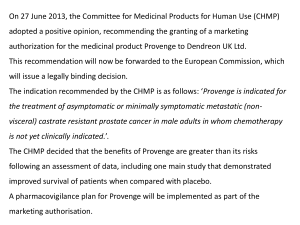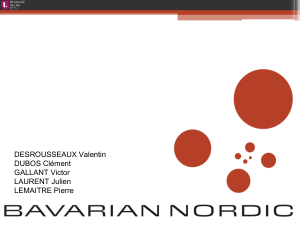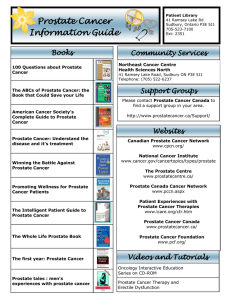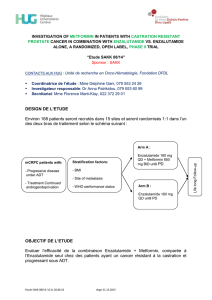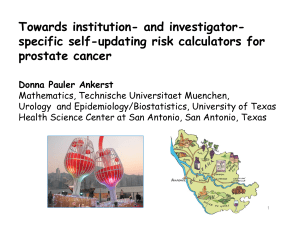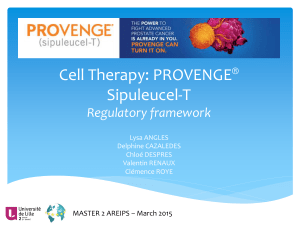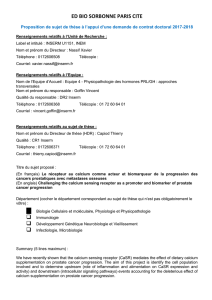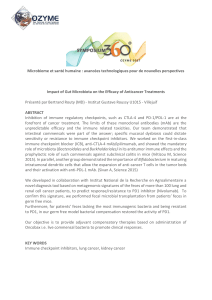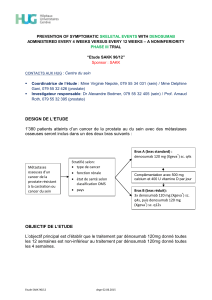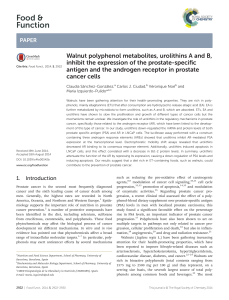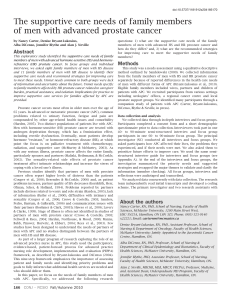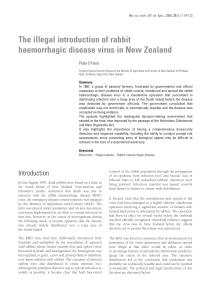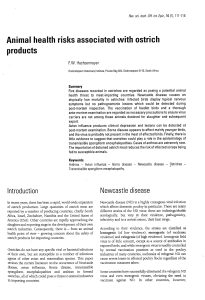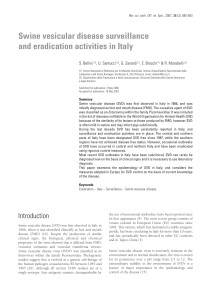2009_-_Immunotherapy_cancer_prostate.pptx
publicité
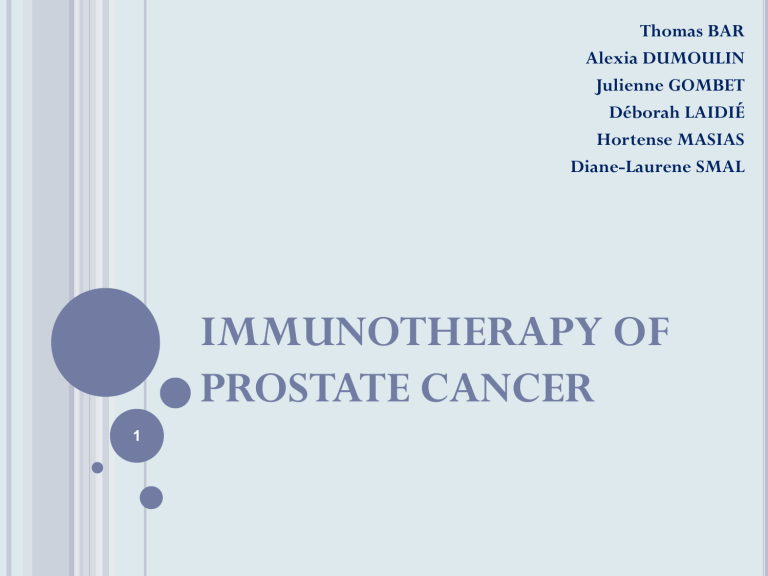
Thomas BAR Alexia DUMOULIN Julienne GOMBET Déborah LAIDIÉ Hortense MASIAS Diane-Laurene SMAL IMMUNOTHERAPY OF PROSTATE CANCER 1 QUESTION Une société pharmaceutique disposant de produits indiqués dans le cancer de la prostate hormono-dépendant souhaite étendre sa franchise vers le cancer non hormono-dépendant. N'ayant pas développé de recherche interne dans ce domaine, elle souhaite acquérir un projet/produit à un stade clinique auprès d'une société de Biotechnologie (ou d'un groupe universitaire). Analyser les différentes approches ayant donné lieu à des développements cliniques : - thérapies cellulaires homologues et hétérologues, - utilisation de virus recombinants. Présenter le rationnel scientifique, les résultats précliniques et cliniques. Faire une étude comparative des résultats publiés. A partir de ces données, faire une recommandation au comité stratégique de la société (quel projet, quel type d'accord) 2 Safe Harbor This is an independent study performed by students from the Faculté des Sciences Pharmaceutiques of Lille. The opinions expressed are our own. 3 PRESENTATION a. b. 4 Disease and current treatments Market WHAT IS THE PROSTATE ? A gland located in front of the rectum and underneath the urinary bladder. The prostate's job is to make some of the fluid that protects and nourishes sperm cells in semen. Its growth is fueled by male hormones : Androgens (DHT) 5 PROSTATE CANCER Prostate cancer is caused by changes in the DNA of a prostate cancer cell - with HBP - HBP will never become cancer Classified as an adenocarcinoma (99%) or glandular cancer (1%) Most of them grow slowly More common than any other cancer in men When caught and treated early, prostate cancer has a 6 high cure rate INSTALLATION OF CANCER 7 SYMPTOMS Frequent urination and increased urination at night Difficulty starting and maintaining a steady stream of urine Blood in the urine Painful urination Problems with sexual function, such as difficulty achieving erection or painful ejaculation. 8 FOLLOW UP OF PATIENTS For all old men: (preconised after 50) DRE and PSA test level A DRE and PSA cannot diagnose prostate cancer : further testing is needed. Doctor may require a biopsy 9 DIAGNOSIS The PSA test measures the level of PSA in the blood. (produced by the body = a biological marker = a tumor marker). serum PSA doubling time The doctor takes a blood sample, and the amount of PSA is measured in a laboratory. Critical level > 4 ng/ml. 10 DIAGNOSIS Digital Rectal Exam (DRE) Doctor feels an induration throught the rectum 11 DIAGNOSIS Prostate Biopsy Biopsy = Urologist guides a needle into the prostate to take small samples of prostate tissue through the rectum. Tissues are then examined under a microscope to determine the Gleason Scale. Urologist assigns a grade to 2 samples. The Gleason score ranges from 2 to 10, with 10 having the worst prognosis. 12 EVOLUTION OF THE DISEASE: TNM STAGES OF PROSTATE CANCER (1) oThe N (lymph node) staging: T1 – The tumour is too small to be seen on scans or felt during examination of the prostate T2 – The tumour is completely inside the prostate gland T3 – The tumour has broken through the capsule of the prostate gland T4 – The tumour has spread into other body organs nearby, such as the rectum or bladder. 13 EVOLUTION OF THE DISEASE: TNM STAGES OF PROSTATE CANCER (2) The N (lymph node) staging: N3 Any positive lymph node that is bigger than 5 cm across N0 No cancer cells found in any lymph nodes The staging for metastases (cancer spread) M0 – No cancer has spread outside the pelvis M1 – Cancer has spread outside the pelvis Lung Prostate cancer tends to spread to the bones rather than any other organs Bone Liver 14 COMPLICATIONS Local Extension Infiltrate and destruct adjoining tissues as the fatty peri prostatic tissu, seminal vesicles, urinary bladder and rectum. Metastatis in other places - Ganglionics - Viscerals (hepatic and pulmonal) - Bony (Prostate cancer tends to spread to the bones rather than any other organs.) 15 ADVANCED PROSTATE CANCER :BONE METASTASIS 1/3 of patients who are treated with conventional curative therapy will develop bone metastases Symptoms: soreness in areas such as the lower back, hips, and thighs. fracture of affected bones severe bone pain 16 MARKERS FOR DISEASE PROGNOSIS Disease prognosis based on serum PSA doubling time growth of the tumor Gleason scale with or without metastatis 17 HORMONO DEPENDENT CANCER Efficient treatments Possible evolution 18 CURRENT TREATMENTS Cancer Hormono dependent Surgery : prostatectomy Radiotherapy Curitherapy With or without Hormonotherapy Hormone treatment slows the tumour growth by blocking testosterone production, or alternatively by blocking testosterone activity. Therapy used to treat advanced stage or metastatis. 19 HORMONOTHERAPY … drugs LH-RH Agonists and Non-steroïdien Anti-androgens Androcur ® Enantone® Decapeptyl® Decrease testosterone after 2 to 3 weeks. - Inhibit the binding of testosterone with intracellular receptors. - Inhibit the negative retrocontrol. Other hormonal agents Progestatifs : escape after a few months. 20 … A CAUSE OF FATAL EVOLUTION Escape to the treatment Cancer growth by another way … Cause of hormono refractory cancer prostate 21 PROGRESSION OF PROSTATE CANCER Pathways involving Androgen receptor Pathways bypassing the androgen receptor 22 FROM HORMONO-DEPENDENT TO HORMONE-REFRACTORY PROSTATE CANCER Hyperexpression of androgens receptors Mutation of androgens receptors Excessive recruitment of transcriptional co-activators Interaction with others signal ways The question is : How to treat the hormonoindependent cancer ?? 23 CURRENT TREATMENTS Hormone-refractory prostate cancer Chemotherapy Docetaxel and Taxotere might give to the patient an extra few months… 24 Study TAX327 : global survival of HRPC . Tannock et al. [25]. CYTOTOXIC CHEMOTHERAPY Docetaxel and Taxotere : not specific for the prostate cancer Side effects : nausea, vomiting, hair loss and leucopenia 20 000$ / years in US !! Not appropriate for at least 25% of patients Try to make better !!! A new challenge for pharmaceuticals industries 25 PRESENTATION a. b. 26 Disease and current treatments Market EPIDEMIOLOGY (DATABASE OF AMERICAN CANCER SOCIETY) USA : about 186 350 new cases in 2008 World : 500 000 new diagnosed patients/year About 1 man in 6 will be diagnosed with prostate cancer during his lifetime, but only 1 man in 35 will die of it. (140 000 related deaths annually) The second leading cause of cancer death, just behind only lung cancer. Prostate cancer accounts for about 10% of cancerrelated deaths in men. 27 RISK FACTORS FOR PROSTATE CANCER Age : after a man reaches age 50. Incidence is rising in line with the aging population. 32,4 % Family history : Inherited genes that seem to raise prostate cancer risk. 28 AN INTERESTING SECTOR 29 www.phrma.org | www.innovation.org | www.pparx.org | www.buysafedrugs.info | www.sharingmiracles.com TREATMENTS EVOLUTION Prostate Cancer therapies 2007-2017 : Market share 2007 2017 Total : USD 3,266.5 million Total : USD 4,468.4 million 11% 16% 17% 45% 84% Chemotherapeutic agents Hormonal agents 27% Chemotherapeutic agents Hormonal agents Vaccines Targeted agents 30 A VACCINE : A NEW SOLUTION ? 31 A VACCINE : A NEW SOLUTION An immunologic approach to stimulate the Immune System Purpose : To find the good antigens specific of the tumor and develop a cytotoxic response against them → long term !!!! They are probably more effective in cancers that progress slowly, such as prostate cancer. 32 PROSTATE CANCER … THE FIRST IN VACCINATION? 1. Slow growth 7. Long lasting therapeutic effects 2. Diagnosed early PROSTATE CANCER AS A VACCINE PROTOTYPE 3. Serum PSA doubling time 6. Association with hormono therapy 5. New paradigms 4. Identified & characterized Antigens 33 CANCER IMMUNOTHERAPY A deficience of the Immune System responsible of the tumor (tolerance) The goal of cancer immunotherapy is to induce cytotoxic T lymphocyte (CTL) antibody immune responses against antigens tumor specific 34 TWO DIFFERENT WAYS Cancer cells 35 HOW MAKE CANCER VACCINE ? 2 differents ways Cellular immunity : to reeducate the Immune System Autologous DENDREON : PROVENGE ® Allogenic By virus BAVARIAN NORDIC : PROSTVAC ™ – MVA-BN-PRO ® Humoral immunity : to stimulate the Immune System Antibodies All of them are curative methods 36 THE GOOD TARGET… = The good antigens which is specific of the tumor Vaccines develop a cytotoxic response against them Prostate Tumor antigens : • PSA • PAP 37 PSA : PROSTATIC SPECIFIC ANTIGEN Glycoprotein, mostly product by the prostate Circulated molecule Elimination half-life of PSA : 2,2 days Increase if prostate cancer / HBP / inflammation or infection Both diagnosis and follow-up 38 PAP : PROSTATIC ACID PHOSPHATASE Tumor-associated antigen Circulated molecule 102 kDa glycoprotein Its expression is restricted to the prostate tissue 39 Three Ways for Self Antigens to Become Tumor Antigens 40 1. CELLULAR a. b. c. d. 41 Remember… Autologous therapy Allogenic therapy By virus IMMUNITY VACCINATION CONCEPT APC Integration PSA PAP 42 CMH I PRESENTATION : THE ENDOGENOUS WAY APC 43 Time : only 30 minutes !!! CMH CLASS I Presents endocellular Ags to LcT CD 8 Peptides containing 8 to 10 AA (Viral or tumoral Ags, Self Ag) 44 INTERACTION WITH LCT CD8 CMH CLASS 1 + cytokines attract LcT CD 8 Activation CD8 Proliferation Proliferation (CTL) TCR peptide 45 IL-1, IL-6, TNF-a, IL-12, IFN-g APOPTOSIS tumorale Cell lysis Tumor destruction 46 1. CELLULAR a. b. c. d. 47 IMMUNITY Remember… Autologous therapy Heterologous therapy By virus Homologous therapy 2) Boosted cells 1) Sample of patient’s cells 48 3) Re-injection in the same patient Dendreon Corporation (NASDAQ: DNDN), a Seattle-based biotechnology company, is focused on targeting cancer (woths 2 419,26 MUSD) Dendreon applies its expertise in Active Cellular Immunotherapy (ACI) product candidates designed to stimulate an immune response Dendreon's lead ACI product candidate known as Provenge® (sipuleucel-T) is in late-stage development for the treatment of men with metastatic, AIPC In addition to ACI product candidates, the company is researching small molecule product candidates for a variety of cancers 49 PIPELINE SMALL MOLECULES ACTIVE CELLULAR IMMUNOTHERAPIES Research Development Phase I Phase II Phase III FDA Market PROVENGE (sipuleucel-T) Androgen-independant-hormone-refractory prostate cancer Androgen-dependant prostate cancer NEUVENGE (lapuleucel-T) Ovarian, colorectal, breast, bladder CAS Kidney, colon, cervical CEA Breast, lung, colon TRPM8 Prostate, breast, lung, colon, BHP 50 PROVENGE® 51 ACTIVE CELLULAR IMMUNOTHERAPY (ACI) Active Cellular Immunotherapy: Administration of live human cells to reengage patient’s own immune system Goal: Elicit a specific and long-lasting response against cancer 52 HOW DOING ACI? Activated T cells may be the immune system’s most potent defense against cancer T cells: Activated by antigen presenting cells (APCs) in a stimulatory environment to recognize tumor-associated antigens Once activated, can eliminate cells bearing those antigens 53 PROVENGE®: HOW IT WORKS? PA2024 antigen is a recombinant protein consisting of human PAP fused through its COOH terminus to the NH2terminus of GM-CSF by a Gly-Ser linker PAP COOH NH2 GM-CSF Recombinant PAP antigen combines with resting APC PAP Gly-Ser GM-CSF DC PA2024 54 WHAT IS GM-CSF? Granulocyte/Macrophage – colony stimulating factor GM-CSF is a cytokine that functions as a white blood cell growth factor GM-CSF stimulates stem cells to produce granulocytes -neutrophils -eosinophils -basophils and monocytes 55 PROVENGE®: HOW IT WORKS? APC takes up the antigen Antigen is processed and presented on surface of the APC 56 INTERACTION WITH LC T… 57 PROVENGE®: HOW IT WORKS? Recombinant PAP antigen combines with resting APC Antigen is processed and presented on surface of the APC APC takes up antigenthe Fully the activated, APC is now T-cells proliferate Provenge activates Provenge® and attack T-cells in the body cancer cells DURING MANUFACTURING 58 INTERACTION WITH LC T… 59 PROVENGE®: HOW IT WORKS? Provenge activates T-cells in the body T-cells proliferate and attack cancer cells The precise mechanism of Provenge® IN THE in prostate cancer PATIENT has not been established 60 SIPULEUCEL-T CONCEPT 1°) APCs are obtained from the patient via a standard leukapheresis procedure 2°) Patient's APCs are then transported to a Dendreon manufacturing facility where they are co-cultured with a recombinant fusion protein containing PAP 3°) The activated, antigen-loaded APCs (now Provenge®) are then delivered to the physician's office (infusion site) for infusion into the patient 4°) Sipuleucel-T is then infused into the patient, where it can potentially stimulate a T cell response against prostate cancer cells 61 APHERESIS Apheresis is a medical technology in which the blood of a donor or patient is passed through an apparatus that separates out one particular constituent and returns the remainder to the circulation. LEUKAPHERESIS leukapheresis is a laboratory procedure in which white blood cells (DCs) are separated from 62 a sample of blood SIPULEUCEL-T: PROVENGE® DEVELOPMENT Provenge® described by Dendreon: “Sipuleucel-T is in late-stage development for the treatment of metastatic, androgen-Independent cancer….. ….If approved, sipuleucel-T could fill a gap in the treatment continuum for the thousands of men with AIPC who currently have limited effective options” 63 A SOLUTION TO REFRACTORY FORM Provenge® 64 PROVENGE ® 65 CLINICAL TRIALS AND REGULATION PROVENGE® (APC8015) Clinical trial phase I 66 PROVENGE DEVELOPEMENT HISTORY Dec 96 Phase I started PROVENGE 67 PROVENGE®(APC8015) CLINICAL TRIAL PHASE I Priming Tissue-specific Cellular Immunity in a Phase I Trial of autologous Dendritic Cells for Prostate Cancer This Phase I trial was designed to evaluate the safety and the maximum tolerable dose of PA2024 administered s.c. after two i.v. infusions of APC8015 68 PATIENTS AND METHODS Eligible for the study histologically proven adenocarcinoma refractory to hormonal treatment 13 patients were included Others eligibility AGE >18 yrs PSA ≈5.0 ng/ml requirements PAP ≤ twice the upper limits of normal TREATMENT SCHEDULE 69 DESIGN 12 patients could be evaluated for the response to treatment ASSESSMENT Patients were monitored - physical examination - blood counts, serum chemistry - measurements of PSA and PAP every 4 weeks during treatment (weeks 0–16). Tumor burden was evaluated by radiography 70 PREPARATION OF ANTIGEN-LOADED DENDRITIC CELLS Clontech Laboratories, Inc PA2024 was cloned into the pBacPAK8 vector 71 PREPARATION OF ANTIGEN-LOADED DENDRITIC CELLS PA2024 gene In-fusion cloning Miniprep and sequences clones Co transfered pBacPAK8 and BacPAK6 DNA into Sf21 insects cells PA2024 released into the culture supernatant PA2024 is purified for this trial by three sequential column chromatography steps to .90% purity pBacPAK8 vector Recombinant bacilovirus Sf21 insects cells 72 ANTIGEN-LOADED DENDRITIC CELLS SYNTHETISIS PAP loaded autologous dendritic cells were prepared at the Mayo Clinic Cell Processing Center: The leukapheresis product was collected at the adjacent Mayo Blood Bank and transferred to the Cell Processing Center 73 ANTIGEN-LOADED DENDRITIC CELLS SYNTHETISIS 3. 2. Dendritic cells precursors PBMC peripheral blood mononuclear cell 4. Leukapheresis product 74 1. Mayo Blood Bank ANTIGEN-LOADED DENDRITIC CELLS SYNTHETISIS 3. 2. Dendritic cells precursors PBMC peripheral blood mononuclear cell 4. Leukapheresis product 75 1. Mayo Blood Bank RESULTS IN VITRO X-axis weeks 0,4,8,12,16 and 20 Y-axis Proliferation index Z-axis Concentration of antigen 0,4 ;2,0 ;10,0 ;50,0 µg/mL Index proliferation of T-cells 76 RESULTS IN VITRO X-axis weeks 0,4,8,12,16 and 20 Y-axis Proliferation index Z-axis Concentration of antigen 0,4;2,0;10,0;50,0 µg/mL Index proliferation of T-cells 77 RESULTS IN VITRO X-axis weeks 0,4,8,12,16 and 20 Y-axis Proliferation index Z-axis Concentration of antigen 0,4;2,0;10,0;50,0 µg/mL Index proliferation of T-cells 78 RESULTS: LEVELS OF PSA AND PAP 79 PSA PAP PROVENGE (APC8015) 80 A phase II trial PROVENGE ®(APC8015) CLINICAL TRIAL PHASE II The goal is to follow : Patients physical conditions Immune response Laboratory parameters DESIGN APC8015 was administered three subcutaneous injections of 1.0 mg intravenously of PA2024 (0.5 mg into each thigh) Week 0 2 4 8 12 81 HOW TO EVALUATE THE IMMUNE SYSTEM STIMULATION? 104 100 101 102 103 104 # of cells 102 103 104 100 101 102 103 104 60 0 100 101 102 103 104 100 101 102 103 104 60 0 Counts Counts Counts CD54 Counts 60 0 101 60 100 HLA-DR (MHC) 100 101 102 103 104 100 101 102 103 104 60 103 Counts 102 0 101 60 100 0 Day 2 Counts Counts 0 0 Day 0 Counts 60 60 APC take up the antigen and express the cell surface marker CD54 Antigen presenting cells show increased expression of costimulatory molecules CD54 positive cells stimulate PAP-specific T cell clones 0 CD86 CD40 82 Small, et. al. 2000, J. Clinic. Oncology 18:3894 Increased expression RESULTS: SIPULEUCEL-T PHASES 1 & 2 TRIALS (MAYO CLINIC AND UCSF) Safety • No dose limiting toxicities • Treatment well tolerated Immune Responses • Regimen: maximum immune responses reached after 3 infusions • T cell responses were specific [not increased to recall flu antigen or KLH] 83 PHASE I AND II TRIALS CLINICAL EFFECTS PSA decline of > 50% in 6/62 (10%) of AIPCa patients Objective (bidimensional mass) response observed Immune responses correlated with prolonged time to objective progression Prolongs PSADT in ADPC 84 PROVENGE DEVELOPEMENT HISTORY Dec 96 Phase I started PROVENGE Nov 98 FDA DNDN End of phase II meeting To discuss design of Phase III 85 PHASE III CLINICAL TRIALS 86 D 9901, D 9902A and IMPACT study PROVENGE DEVELOPMENT HISTORY Dec 96 Phase I started 99 DNDN and FDA Agreement TTP vs Placebo As primary-endpoint Two identical phase III PROVENGE Nov 98 FDA DNDN End of phase II Meeting to discuss design of Phase III Jan 00 Phase III D9901 started May 00 Phase III D9902 started 87 D 9901 AND D 9902 STUDIES Same design: • Multicenter • Randomized • Double-blind • Placebo-controlled • Primary endpoint: Time to disease progression (TTP) Radiographic, Clinical or Pain Not PSA o Survival was not an endpoint • Enrollement D 9901: 127 men with asymptomatic, metastatic, androgen-independent (hormone refractory) prostate cancer 88 T-CELL MEDIATED IMMUNE RESPONSE 89 D9901 PRIMARY EFFICACY ANALYSIS (ITT) 90 TABLE SUMMARIZES THE SURVIVAL RESULTS OF THE FIRST PROVENGE PHASE III STUDIES 91 PROVENGE DEVELOPEMENT HISTORY Dec 96 Phase I started 99 DNDN and FDA Agreement TTP vs Placebo As primary-endpoint Two identical phase III Oct 02 D9901 analysis demonstrated that overall study were negative PROVENGE Nov 98 FDA DNDN End of phase II Meeting to discuss design of Phase III Jan 00 Phase III D9901 started May 00 Phase III D9902 started 92 PROVENGE DEVELOPEMENT HISTORY Dec 96 Phase I started 99 DNDN and FDA Agreement TTP vs Placebo As primary-endpoint Two identical phase III Oct 02 D9901 analysis demonstrated that overwall study were negative PROVENGE Nov 98 FDA DNDN End of phase II meeting To discuss design of Phase III Jan 00 Phase III D9901 started May 00 Phase III D9902 started Nov 02 FDA agreement For spliting D9902 in 2 D9902A including patients enrolled regarless 93 of gleason score D9902B patients with Gleason scored ≤7 MODIFICATION OF D9902 D9901: Observation of increased TTP among patients with Gleason score ≤ 7 D9902A: stopped early: limited patients recruitement Insufficient sample size to detect a difference in TTP or overall survival No statistical difference in TTP and OS? D9902B: restricted to patients with Gleason score ≤7 Renamed IMPACT 94 THE IMPACT TRIAL: IMMUNOTHERAPY PROSTATE ADENOCARCINOMA TREATMENT Modification of the primary endpoint: OVERALL SURVIVAL Secondary endpoint: time to disease progression DESIGN: 95 IMPACT OVERALL SURVIVAL: PRIMARY ENDPOINT INTENT-TO-TREAT POPULATION 96 IMPACT ON EXCHANGE RATE 97 PROVENGE DEVELOPEMENT HISTORY Dec 96 Phase I started 99 DNDN and FDA Agreement TTP vs Placebo As primary-endpoint Two identical phase III Oct 02 D9901 analysis demonstrated that overwall study were negative 0ct 04 D9901 analysis Demonstated that ↗ median survival of patients At 36 months PROVENGE Nov 98 FDA DNDN End of phase II meeting To discuss design of Phase III Jan 00 Phase III D9901 started May 00 Phase III D9902 started Nov 02 FDA agreement For spliting D9902 in 2 D9902A including patients enrolled regarless 98 of gleason score D9902B patients with Gleason scored ≤7 D9901: OVERALL 3-YEAR SURVIVAL INTENT-TOTREAT (POST-HOC STUDY) 99 Post-hoc study: improvement in median survival (p=0,01) TABLE SUMMARIZES THE SURVIVAL RESULTS OF THE FIRST PROVENGE PHASE III STUDIES 100 SAFETY PROFILE COMMON ADVERSE EVENTS (≥ 5%) 101 Higher rate in Provenge® (p<0,05) TO CONCLUDE ON THE IMPACT STUDY First active immunotherapy to demonstrate improvement in overall survival for advanced prostate cancer Highly favorable benefit to risk profile Short duration of therapy Potential to create new treatment paradigm in oncology Validates potential to apply platform across different cancers 102 PROVENGE DEVELOPEMENT HISTORY Sept 2005: Pre-BLA Meeting held with FDA: – Survival benefit observed in Study D9901 – Supported by D9902A – The absence of significant toxicity – Will serve as the clinical basis of a BLA for Provenge® Aug – Nov 2006: Submit rolling BLA PROVENGE Nov 2005: FDA granted Fast Track Status for Provenge® Jan 2007: BLA accepted for Priority Review 103 BLA: BIOLOGICS LICENSE APPLICATION submission that contains specific information on the: manufacturing processes chemistry pharmacology clinical pharmacology medical affects of the biologic product 104 PROVENGE DEVELOPEMENT HISTORY Sept 2005: Pre-BLA Meeting held with FDA: – Survival benefit observed in Study D9901 – Supported by D9902A – The absence of significant toxicity – Will serve as the clinical basis of a BLA for Provenge® Aug – Nov 2006: Submit rolling BLA March 2007: FDA’s Cell, Tissue and Gene Therapies Advisory Committee PROVENGE Nov 2005: FDA granted Fast Track Status for Provenge® Jan 2007: BLA accepted for Priority Review 105 THE WAR OF COMMITEE FDA INTERNS POLITICS ISSUE EFFECT ON PROVENGE DEVELOPMENT CBER CDER Center for Bioligs Evaluation and Research Center for Drugs Evaluation and Research View its role as: - Nurturing complex/novel technologies - collaborating with the companies to bring them to patients Consistently : - Raise the efficacy bar - Reject applications that do not adhere to rigorous statistical standards 106 Transferred responsabilities for biologis therapeutics PROVENGE BLA MEETING APRIL 2007 Is composed of outside experts “Approve a therapy poorly efficacy profile could - Prevent patients from receiving effective therapy - Create perverse incentives for industry” CDER’s ODAC Oncologic Drug Advisory Commitee FDA advisory commitee never made a recommendation about a BLA or NDA CBER officials Office of Cellular, Tissue and Gene Therapies have more expertise in the underlying technology than in the disease, as well as an institutional 107 leaning toward advancing novel approaches to patients PROVENGE BLA MEETING APRIL 2007 Key Questions to the Committee – Is sipuleucel-T reasonably safe for the intended patient population? 17 yes – 0 no – Has substantial evidence of efficacy been established? 13 yes – 4 no Still CBER may find it difficult to interpret the committee’s advice because many of the positive votes 108 were accompanied by qualifying remarks more based on hope than conviction PROVENGE DEVELOPEMENT HISTORY Sept 2005: Pre-BLA Meeting held with FDA: – Survival benefit observed in Study D9901 – Supported by D9902A – The absence of significant toxicity – Will serve as the clinical basis of a BLA for Provenge® Aug – Nov 2006: Submit rolling BLA March 2007: FDA’s Cell, Tissue and Gene Therapies Advisory Committee PROVENGE Nov 2005: FDA granted Fast Track Status for Provenge® Jan 2007: BLA accepted for Priority Review May 8, 2007 Complete Response Letter Request for additional 109 clinical and CMC information DENDREON: TUMULTEOUS REGLEMENTARY On May 8, 2007 , Complete Response Letter, commonly referred to as an "approvable" letter from the US FDA regarding Provenge® Biologics License Application (BLA) The FDA has requested - Additional clinical data - Additional information with respect to the chemistry, manufacturing and controls (CMC) section of the BLA 110 PROVENGE® SUPPORTERS: RAISE OF VOICE Raise A Voice Sends Message to FDA “…. Given the following points, we would like to reaffirm our position on the need for more treatments with less side effects for advanced prostate cancer…” The very favorable risk-benefit ratio of Provenge. The necessity for more treatments for advanced and hormone refractory prostate cancer based on the current US death rate of approximately 27,000 men a year 111 REASONS OF FDA’S RELUCTANCES Nature of post-hoc D9901 analyses concerning survival difference Primary endpoint change: TTP (Time To disease Progression) or Survival data?? DNDN acknowledges that it does not fully understand the mechanism of action Side effects: the increasing risk of Cardiovascular events Many of the positive votes from the Advisory commitee were accompanied with remarks more based on hope than conviction 112 PROVENGE DEVELOPEMENT HISTORY Sept 2005: Pre-BLA Meeting held with FDA: – Survival benefit observed in Study D9901 – Supported by D9902A – The absence of significant toxicity – Will serve as the clinical basis of a BLA for Provenge® Aug – Nov 2006: Submit rolling BLA March 2007: FDA’s Cell, Tissue and Gene Therapies Advisory Committee PROVENGE Nov 2005: FDA granted Fast Track Status for Provenge® Jan 2007: BLA accepted for Priority Review 2010 IMPACT Final Results May 8, 2007 Complete Response Letter Request for additional 113 clinical and CMC information DENDREON: A RELIABLE BUSINESS MODEL? DNDN Intellectual Property is based on: Dendreon own or license issued patents or patent applications that are directed to the solutions and devices by which cells can be isolated and manipulated Antigen Delivery Cassette, Antigen-presenting cell processing, 114 DENDREON: A RELIABLE BUZINESS MODEL? Pursuing commercial arrangements with other vendors To establish network of commercial leukapheresis suppliers For clinical trials → commercial carriers for these transportation needs Dendreon: “ it is anticipated that such carriers will be sufficient to fulfill our commercial transportation needs” 115 DENDREON: A RELIABLE BUZINESS MODEL? To support the potential commercialization of Provenge, Dendreon have invested in manufacturing facilities and related operations. The initial build-out the 158,242 square foot commercial manufacturing facility in Morris Plains, New Jersey (the “Facility”) was completed in July 2006 116 DENDREON: A RELIABLE BUSINESS MODEL? To perform leukapheresis for clinical trials, Dendreon rely upon: - blood banks (Mayo Clinic) - hospitals - and other health care providers To act as providers of commercial leukapheresis services Dendreon have agreements with: - Puget Sound Blood Center - New York Blood Center 117 DENDREON: A RELIABLE BUSINESS MODEL? DNDN is actively pursuing commercial arrangements with other vendors 118 in order to have an established network of commercial leukapheresis suppliers DENDREON: A RELIABLE BUSINESS MODEL? AGREEMENT TO MANUFACTURE PA2024 Dendreon Tm. Diosynth Biotechnology inc. March 2001: To scale-up to commercial levels of production of the Antigen delivery Cassette used in Provenge,DNDN contracted with Diosynth RTP, Inc DNDN plan to use third party contractors to produce commercial quantities of devices and media for Provenge, assuming Provenge is approved for sale. 119 DENDREON: A RELIABLE BUSINESS MODEL? HOW TO TARGET PHYSICIANS? 125 PERSON-SALES-FORCE • 5000 ONCOLOGISTS • 3000 UROLOGISTS 120 WHOLESALE PRICE Vaccine cost Blood sample price Vaccine handling price Transport price It is difficult to forecast its price because it is the first active immunotherapy in advanced prostate cancer 121 WHAT KIND OF PROBLEMS DENDREON MAY ENCOUNTER??? DNDN, currently in development: “Our transportation network, manufacturing facilities, leukapheresis providers, and physician infusion centers will be linked with an information technology scheduling solution..” 122 SWOT ANALYSIS STRENGHT WEAKNESSES • Generates active immune response • Few adverse events (vs docetaxel) • Regulatory: individualized treatment (potency of lots) • Ability of Provenge® (APC8015) to induce an immune response against the patient’s prostate cancer is unknown OPPORTUNITIES THREATS • Requirement for apheresis/in vitro • manipulation (increased cost and time) • Technology may not be available in all areas • Is it feasible for a pharmaceutical company? • The first to culture APCs • Do not be compare to docetaxel but vs placebo • To be a « first-in-class » • First in this indication 123 NEXT STEP: ANDROGEN DEPENDENT CANCER? 124 1. CELLULAR a. b. c. d. 125 Remember… Autologous therapy Allogenic therapy By virus IMMUNITY Allogeneic therapy 2) Cells preparation Mixture of allogeneic cells, irradiated so they can’t grow or divide 1) Culture of prostate cells 126 cells that grow indefinitely in culture 3) Injection in the patient HOW DOES IT WORK ? Prostate antigens viewed as foreign by the immune system : trigger an immune response against them correct the immune deficit caused by cancer Inducts cellular immunity : immune response including both polyclonal CTL and CD4 activation 127 Delayed Disease Progression after Allogeneic Cell Vaccination in Hormone-Resistant Prostate Cancer and Correlation with Immunologic Variables Agnieska Michael1, Graham Ball3, Nadine Quatan1, Fatima Wushishi2, Nick Russell2, Joe Whelan2, Prabir Chakraborty4, David Leader1, Michael Whelan2 and Hardev Pandha1 Advantages o To target simultaneously multiple tumor markers express a broad range of known or unknown cancerspecific markers specially interesting in a cancer that mutates rapidly minimizing the ability of the tumor cells to evade detection o The cells are not matched to the patient they are capable of generating a more potent immune response.. o Genetic material easy to produce 128 SOME SIDE EFFECTS • Immunogenicity • Safety problems (virus) 129 FEW EXAMPLES… 130 Onyvax-P Onyvax-P is a combination of three inactivated cell lines that are representative of different stages of the disease. This study follows the successful completion of a Phase IIa trial in which almost half of the patients showed significant decreases in their PSA velocity. In addition, the time to disease progression was lengthened relative to that normally expected in a population at this stage of the disease 131 Decrease in PSA velocity The ratio of PSA doubling time (PSADT) for each patient pre- and postvaccination has been plotted. A ratio greater than one indicates an elongation of PSADT. *, statistically significant (P < 0.05) alterations of PSADT. 132 Delayed Disease Progression after Allogeneic Cell Vaccination in Hormone-Resistant Prostate Cancer and Correlation with Immunologic Variables Agnieska Michael1, Graham Ball3, Nadine Quatan1, Fatima Wushishi2, Nick Russell2, Joe Whelan2, Prabir Chakraborty4, David Leader1, Michael Whelan2 and Hardev Pandha1 GVAX one example … that fails GVAX : whole cells derived from two prostate cancer lines modified to secrete GM-CSF (immune stimulatory cytokine), and irradiated to arrest growth Oct-07 to 08 : VITAL1 Phase III to compare GVAX as <30% chance of meeting its a monotherapy to endpoint predefined primary Taxotere of an improvement in survival: chemotherapy plus terminated the VITAL-1 trial. prednisone VITAL-2 study GVAX plus Taxotere 67 deaths Taxotere plus prednisone 47 deaths 133 GVAX one example … that fails GVAX : whole cells derived from two prostate cancer lines modified to secrete GM-CSF (immune stimulatory cytokine), and irradiated to arrest growth Deaths force halt to Cell Genesys cancer vaccine VITAL-2 study trial GVAX plus Taxotere Oct-07 to 08 : VITAL1 Phase III to compare GVAX as <30% chance of meeting its a monotherapy to endpoint predefined primary Taxotere of an improvement in survival: chemotherapy plus terminated the VITAL-1 trial. prednisone 67 deaths Taxotere plus prednisone 47 deaths 134 1. CELLULAR a. b. c. d. 135 Remember… Autologous therapy Allogenic therapy By virus IMMUNITY CANCER PROSTATE Tumor antigens (PSA-PAP) are dramatically surexprimed in cancer prostate = good targets BUT PSA and PAP are own Ags = tolerated by the immune system IDEA : Educate the immune system to recognize these Ags , that destruct the prostate tumor Purpose of the immunotherapy : To break up the tumor tolerance = VACCIN CONCEPTION 136 A new approach : Viruses as vectors… 137 THE VECTOR TECHNOLOGY “a vector is a living organism that does not cause disease itself, but which spreads infection by “carrying” pathogens from one host to another” What is a vaccine vector? Weakened or killed version of a virus or bacterium Carries an inserted antigen from a disease causing agent to the vaccinee 138 THE VECTOR TECHNOLOGY Why? To deliver the antigen in a natural way into the body Activate the immune system Generate an immune response against the antigen. Uses? Therapeutic Vaccine changes or boosts the immune response after an infection or malignancy curing an already established disease. Prophylactic Vaccine induces an immunological memory prior to infection prevent a disease by rapidly and efficiently responding to and clearing a subsequent infection. 139 MECHANISM Cell T cytotoxic Viral envelope Recognition by cell T cytotoxic Endocytosis MCH Class I molecule linked to peptid through Golgi towards cell surface Target cell Entrance in endosoma MCH Class I molecule linked to peptid Merge β2 Viral ARN in the microglobulin cytosol CMH I chain α ARN viral replication and traduction Peptid binded to chainα ; towards Golgi Towards RE Viral protein proteolysis in proteosoma 140 TWO DIFFERENTS WAYS Cancer cells 141 THE VECTOR TECHNOLOGY How ? A re-engineered virus can be used as the vehicle for delivering genetic material to a cell Once in the cell, genetic information is transcribed into proteins, including the inserted antigen targeted against a specific disease. This protein which starts the body’s immune response against the antigen and thereby protects against the disease. 142 WHICH VIRUSES ? Poxviruses : Fowlpox and Vaccinia Advantages of the Poxviral vectors : - include the large size of the genomes - induce inflammatory response that helps to break self tolerance and induce strong T-cell immune responses against tumor antigen. 143 An industrial Danish biotechnology. The Company's pipeline currently includes a total of 7 development programmes in the following 3 areas : - biodefense cancer infectious diseases Bavarian Nordic is developping 2 products : - PROSTVAC ™ - MVA-BN-PRO ® 144 PROSTVAC ™ 145 A.PRESENTATION B. TRIALS ON CEA-TRICOM C. TRIALS ON PSA-TRICOM D. CONCLUSION 146 WHAT IS PROSTVAC ™? A prime boost vaccine that incorporates 3 costimulatory molecules as well as the prostate specific antigen (PSA) tumor antigen, for the potential treatment of prostate cancer. It is designed to stimulate and strengthen the body's immune system (LcT) to kill prostate cancer cells. 147 PROSTVAC ™ CONCEPTION : CEA- TRICOM At the root … Therion Biologics, the National Cancer Institute and Aventis Pasteur are investigating CEA-TRICOM. Vectors = attenuated virus - Recombinant vaccinia vector which is replication competent and is good for prime boost. - Recombinant fowlpox or avipox vector which is a nonreplicating virus and is good for repetitive immune boosting.148 IMPACT OF INJECTIONS ORDER 149 PROSTVAC ™ CONCEPTION : CEA - TRICOM CEA = carcinoembryonic antigen more expressed in the human tissue and implicated in the metastatic process. Altering the amino acid sequence of the tumor antigen to enhance its immunogenicity: Vaccine has encoded a CEA sequence which has a single alteration in HLA-A2 epitope at position 155; 150 PROSTVAC ™ CONCEPTION : CEA - TRICOM 3 Costimulators : TRICOM = B7-1, ICAM-1 and LFA-3 TRIad of COstimulatory Molecules Aim: Elicit strong cellular immune responses necessary for complete tumor destruction. - B7-1 = CD80 : recognition molecule - ICAM-1 / LFA-3 : adhesion molecule 151 . ROLE OF THE B7–CD28 INTERACTION 152 Regulation of T-Cell Activation WHY 3 COSTIMULATORS ? - Study on Murine adenocarcinoma cells : MC38, infected with costimulators - Measure by radioactivity method - P = 0.0001 Results of this association is a significant improvement in antigenspecific T-cell responses. 153 PROSTVAC ™ CONCEPTION : CEA - TRICOM GM-CSF : (Granulocyte-Macrophage Colony-Stimulating Factor) To enhance vaccine efficacy via a recruitment of dendritic cells to regional nodes of the vaccination site. With GM-CFS Without GM-CFS 154 VACCINE CONCEPT : ASSOCIATION OF ALL ACTORS The use of viral vectors-based vaccines with prime and boost (fowlpox/vaccinia) GMCSF DNA a CEA sequence which has a single alteration in HLA-A2 epitope VIRUS The use of T-cell costimulators B7-1/ICAM1/LFA3 155 INJECTIONS SCHEMA *priming and boosting protocol using two unique pox virus vectors, - rV-CEA-TRICOM (recombinant vaccinia vector) - rF-CEA-TRICOM (recombinant fowlpox vector). Vaccinia-CEA-TRICOM Fowlpox-CEA-TRICOM 156 A.PRESENTATION B. TRIALS ON CEA-TRICOM C. TRIALS ON PSA-TRICOM D. CONCLUSION 157 PRECLINICAL TRIALS Conducted by the NCI and Therion, researchers have demonstrated that this combination of three costimulatory molecules dramatically boosts the immune response to eradicate cancer in murine models. SURVIVAL TUMOR VOLUME Immunogen Day 14 Day 35 HBSS 698±928 3674±3107 rV-CEA 259±0 1112±1685 rV-CEA/B7-1 150±236 2696±1936 rV-CEA/TRICOM 0±0 0±0 This association increases antitumor activity 158 ELISPOT Measure the amount of IFN-Y released by PBMCs in response to stimulation with a CEA agonist peptide. www.elispotinfo.com/?page=elispot-flash-animation Analysis • Number of cells is determinate via the cell’s secretion • One activating cell, which products IFN Y = one spot • Number of spots= the number cells 159 RESULT OF ELISPOT 10 / 13 of the HLA A2 positive patients mounted CEA specific T-cell responses with a greater than two-fold increase after 4 vaccinations vs before vaccination Peptide vaccine helpful for HLA-A2-positive patients with prostate cancer 160 ADAPTATION TO THE PROSTATE CANCER PSA = Tumor prostate Ag Therion apply this technology to the prostate cancer : PSA used instead of CEA. 161 A.PRESENTATION B. TRIALS ON CEA-TRICOM C. TRIALS ON PSA-TRICOM D. CONCLUSION 162 GALENIC FORMULATION PROSTVAC will be formulated as a frozen liquid formulation in single dose vials for SC injection. PROSTVAC is not an individualized therapy, but an off the shelf vaccine, ready for immediate use. PROSTVAC is given as monthly injections starting with a Vaccinia-PSA-TRICOM priming dose and followed by 6 monthly Fowlpox-PSATRICOM boosts. 163 PHASE II :CLINICAL TRIAL Randomized, controlled study including 125 patients with metastatic, androgen independant, asymptomatic prostate cancer Randomization with or without biphosphonates Average : 73 years old, prostate cancer for 8.5 years, PSA = 149 ng/mL Primary endpoint : progression free survival = proportion of patients alive and progression free at the end of the 24 weeks study 164 (wild type folwpox) Week 12 Week 16 Week 20 Empty vector (wild type folwpox) Empty vector (wild type folwpox) Empty vector (wild type folwpox) Week 8 Empty vector (wild type folwpox) Week 4 Empty vector (wild type folwpox) Week 2 Empty vector (wild type folwpox) Empty vector (wild type folwpox) Empty vector rF PSA TRICOM rF PSA TRICOM rF PSA TRICOM rF PSA TRICOM rF PSA TRICOM rF PSA TRICOM rF PSA TRICOM rV PSA TRICOM PSA-TRICOM VS PLACEBO Vaccine arm , n=84 R E S Week 24 U L T S 165 Control arm with placebo , n=41 All patients received GM-CSF at the vaccine site on the day of vaccination and for 3 subsequent consecutive days. PHASE II RESULTS : R E S U L •No significant difference between PROSTVAC-VF and Control in the primary endpoint of progression-free survival. p = 0.28 • BUT : Among people were not taking bisphosphonate at baseline (58%) : 37.5% under placebo have died 22% with PROSTVAC have died T S • So, Therion decided to launch a Phase III clinical trial = PARADIGM Including men without measurable metastatic disease 166 and not taking biphosphonates. Primary endpointwill be time to overt metastatic disease. Therion technologies shut down in 2006 after disappointing clinical trial results from a cancer vaccine that didn’t pass late stage clinical trials. They were bought by Bavarian Nordic in june of 2006. B.N got to claim all the glory instead. Therion, the first licensee of this technology, went belly up on adverse events in their trials. 167 ANOTHER PHASE II WITH BAVARIAN NORDIC They called back all the 125 patients enrolled in the first study. New result in a statistically significantly longer median overall survival of 8.5 months on PROSTVAC™ compared to the control group after a 4 years follow-up. New significativity P= 0.0156 168 PHASE II PLACEBO-CONTROLLED STUDY 169 A.PRESENTATION B. TRIALS ON CEA-TRICOM C. TRIALS ON PSA-TRICOM D. CONCLUSION 170 PROSTVAC ™ IN THE FUTURE PROSTVAC would have the potential to significantly extend the lives of people (8.5 months) with advanced prostate cancer with metastasis and treatment options have previously been very limited (Taxotere = 2 months of survival). PROSTVAC has a very good safety and tolerability profile. A RELEVENT DRUG ??? Bavarian Nordic have begun preparations for a phase III confirmatory trial and is looking for a partner to join forces on the development and commercialization of PROSTVAC… 171 PROSTVAC ™ SWOT ANALYSIS STRENGTH •On the shelves •Safety on long term WEAKNESSES •Deadline of patents •HLA A2 : 50% of population •Add of some elements •Prostvac on sale •6 injections OPPORTUNITIES •Ageing population •Hormono-therapy resistance •Vaccine = a new approach THREATS Comparaison with Taxotere • Concurrence • 172 MVA-BN PRO ® 173 A. TECHNOLOGY B. SAFETY C. EFFICACITY D. PROBLEMS ASSOCIATED 174 POX VIRUSES AS VECTORS The most commonly used because of : Ability to replicate in the infected cell’s cytoplasm instead of the nucleus The vaccinia and variola viruses are the two best known of the pox viruses (member of the orthopox family of viruses) : The variola virus is the cause of smallpox The vaccinia virus is used as a vaccine to prevent the disease 175 HISTORY OF VACCINIA VIRUS Vaccinia virus related to the cowpox virus Edward Jenner : vaccination of humans with a vaccinia virus prevents infection of the smallpox virus due to cross-immunity in the orthopox family of viruses BUT : fatal in immuno-compromised populations! Studies to attenue the virus virulence of Vaccinia 176 POTENTIAL OF MODIFIED VACCINIA ANKARA (MVA) MVA : attenuated Vaccinia viruses re-engineered to express foreign genes Robust vectors for production of recombinant proteins High safety profile In animal models: immunogenic protect against various infectious agents influenza, parainfluenza, measles virus, flaviviruses, and plasmodium parasites. 177 PROCESS CVA Chorioallantois vaccinia virus Ankara 516 serial passages in CEF 571 serial passages in CEF MVA 6 major deletions in its DNA Lost approximately 15 % of its genome compromise its capacity to replicate in mammalian cells Modified Vaccinia virus Ankara proved to be extremely attenuated when compared to wild type vaccine virus strains MVA-BN or MVA-571 Bavarian Nordic’s own strain shown to be safe in more then 120,000 individuals Mayr A, Hochstein-Mintzel V, Stickl H. Abstammung, Eigenschaften und Verwendung des attenuierten Vaccinia-Stammes MVA. Infection 1975;3:6–14. (1) 178 BAVARIAN NORDIC’S OWN STRAIN o IGR sites were developed by Bavarian Nordic for integration of genes of interest. o These IGRs were previously shown to be stable and the integrated genes to be functional. 179 VACCINIA VIRUSES RE-ENGINEERED The genes of interest are inserted into intergenic regions (IGRs). ATI promoter cloned in front of the gene Two genes, both under the control of their own ATI promoter, can be inserted into one IGR site without loss of stability or expression Multiple genes can be cloned into a single MVABN virus, resulting in a multivalent “tailored” vaccine. 180 WHAT IS HOMOLOGOUS RECOMBINATION ? Gene of interest Flanking sequences complementary to the ends of a gapped plasmid are added by PCR. Gap is already created in MVA-BN Yeast are transformed with vector and insert, and carry out homologous recombination to repair the gap. 181 POTENTIAL OF BAVARIAN NORDIC’S MVA-BN® MVA technology platform (MVA-BN®) based on a novel monoclonal MVA virus strain IMVAMUNE™: smallpox vaccine Platform for vector technology 182 A. TECHNOLOGY B. SAFETY C. EFFICACITY D. PROBLEMS ASSOCIATED 183 SAFETY Generation of new virus? The resulting recombinant virus (recMVA-BN) Wild type contamination and integration of inserts ? Stability of the inserted genes ? 184 STRONG SAFETY PROFILE OF MVA-BN® 6 major deletions in its DNA Replication cycle is blocked at a very late stage New viruses are not generated and released. virus’ inability to fully replicate in a vaccinated individual 185 STRONG SAFETY PROFILE OF MVA-BN® The virus cannot spread in the vaccinated person Side-effects, normally associated with replicating vaccinia viruses, do not appear Studies with MVA-BN® in immune-compromised individuals have also confirmed its safety and immunogenicity profile 186 TEST FOR WILD TYPE CONTAMINATION Test with HIV tat and gag-pol genes Both gene sequences were derived from the HIV virus clade B. M: molecular weight marker lanes 1–3: DNA of recMVA-BN recMVA-BN lane 4: MVA-BN lane 5: water negative control Wild type MVA-BN Absence of the small wild type band demonstrates absence of MVA-BN in the recMVA-BN No wild type contamination 187 TEST FOR INTEGRATION OF INSERTS Test with HIV tat and gag-pol genes M: molecular weight marker gag-pol gene lanes 1–4: dilutions of recMVA-BN DNA lane 5: plasmid control lane 6: MVA-BN lane 7: water negative control both inserts were integrated no change in the sequence of the vector or inserts tat gene after integration of the genes 188 recMVA-BN is stable !! PROOF OF FUNCTIONAL GENE EXPRESSION Test with HIV tat and gag-pol genes +RT: reaction with reverse transcriptase −RT: reaction without reverse transcriptase control for genomic DNA contamination M: molecular weight marker Gag-pol gene pl: plasmid positive control H2O: water negative control The integration of multiple inserts into one IGR is possible without losing genetic stability and functional gene expression 189 tat gene A. TECHNOLOGY B. SAFETY C. EFFICACITY D. PROBLEMS ASSOCIATED 190 MVA-BN® PRO Strong cellular (CTL) & humoral (Ab) immune response Generates cellular and humoral immune responses to : PSA prostate specific antigen and PAP prostatic acid phosphatase which are both well-known prostate cancer tumor targets 191 PROFILE OF MVA-BN® Elicit an immune response even in individuals with pre-existing immunity against vaccinia ideally suited for homologous prime/boost regimens vaccination with MVA-BN® is much simpler and easier to develop and license MVA-BN® can be applied safely and repeatedly in cases where follow-up vaccinations might be required, such as is the practice with therapeutic vaccines. 192 MVA-BN® PRO A Phase I/II clinical trial 193 MVA-BN® PRO An Open-Label, Phase I Dose Escalation Trial of MVA-BN®-PRO in Men With Androgen-Insensitive Prostate Cancer Primary Outcome Measures evaluate the safety and tolerability of single and multiple injection regimens of MVA-BN®-PRO for the treatment of androgen-insensitive prostate cancer. Secondary Outcome Measures evaluate the ability to generate humoral and cellular immune responses to prostate antigens define an optimal dose for future studie 194 Study in 18 male patients with non-metastatic as well as hormoneinsensitive prostate cancer A. TECHNOLOGY B. SAFETY C. EFFICACITY D. PROBLEMS ASSOCIATED 195 SMALLPOX (ALSO KNOWN AS VARIOLA) Variola major and Variola minorcharacteristic Long-term complications : characteristic scars, Blindness, limb deformities The 20th century : 300–500 million deaths 1967 WHO estimation: 15 million people contracted the disease 2 million died in that year. December 1979 : After successful vaccination campaign the WHO certified the eradication of smallpox 196 SMALL POX: BIG TERROR THREAT « Recent research calls for nonvaccinated individuals to be vaccinated first in the event of a terrorism smallpox attack » 197 MVA-BN PRO : SWOT ANALYSIS STRENGTHS WEAKNESSES • Safety and immunogenicity profile confirmed in immunecompromised individuals •Ideally suited for homologous prime/boost regimens • Response against PSA and PAP • Humoral and cellular response • Only in phase I/II study • No action (elimination of the virus) due to old vaccination OPPORTUNITIES THREATS • Good vector • Recent Patents • A small pox attack • Risk of the virus mutations 198 2. HUMORAL IMMUNITY a. b. c. 199 Carbohydrates, new targets Passive immunotherapy Antibody-Based Therapy PRINCIPE Ab binds Ag on tumor cell surface But PSA and PAP are circulant Ag we must find Ag tumor specific which stay on the cell Seldom tumor specific Ag but surexpression All Ag on the cell are glycosylated There are some differences between them glycan tumor specific : LEWIS Y tumor cell have anormal sugars 200 WHAT ARE CARBOHYDRATES? Carbohydrates (from ‘hydrates of carbon') or are the most abundant of the four major classes of biomolecules. The basic carbohydrate units are called monosaccharides, such as glucose expressed at the cell surface of cancer cells proved to be unexpectedly potents immunogens Targets for immune recognition and attack by antibodies including Glycolipids Glycopeptides Glycoproteins 201 CELL SURFACE TARGETS IN PROSTATE CANCER Normal tissus sTn (c) cancer cells TF (c) Tn (c) 202 HOW TO USE THE CARBOHYDRATES FOR CANCER VACCINES ? « adjuvent setting » is the ideal time After surgery and:or completion of chemotherapy instruct the immune system to identify and kill cancer cells Optimal approach: Antigen + Highly immunogenic carrier protein KLH Induction of - an ANTIBODY RESPONSE against KLH - a T CELL RESPONSE + Adjuvant Increase the immune response against KLH 203 CONSEQUENCES The IgM response persists over 6 weeks, unlike the response against most of the protein antigen 204 OPTIMISATION OF THE ANTIBODY INDUCTION IN PATIENT Polyvalent vaccines: First Results with hexavalent vaccine broke immunologic tolerance against two or more antigens is safe BUT antibody titers against several of the antigens were lower than those seen in individual monovalent trials. No impact on PSA slope was detected 205 OPTIMISATION OF THE ANTIBODY INDUCTION IN PATIENT Fully Synthetic Carbohydrate-Based Vaccines Higher titers of antibodies or Higher immunogenic profile Synthetic structure of TF in the trimer (cluster formation) conjugated to KLH 206 OPTIMISATION OF THE ANTIBODY INDUCTION IN PATIENT Fully Synthetic Carbohydrate-Based Vaccines At 12 months post vaccination: 6 (30%) had decreasing and 14 (70%) had rising logPSA slopes. 8 patients’ disease progressed 12 patients remained progression-free or were censored Toxicity was comparable trials with other antigen-KLH plus QS21 207 The clinical impact of stabilization or decline of PSA log slopes and its relevance as an intermediate endpoint remains to be validated CARBOHYDRATES SWOT ANALYSIS STRENGTH WEAKNESSES • Abundant and potent target at the surface cell • Strong and persistent humoral response • Selective therapy • Early stage of development • Clinical impact of PSA log slopes remains to be validated • Relevance of PSA log as an intermediat endpoint remains to be validated OPPORTUNITIES THREATS • Polyvalent vaccines in the adjuvant setting • Trimer formation can break immunologic tolerance by inducing specific humoral responses • Heterogeneity of the malignancy • Other promising therarpies 208 2. HUMORAL IMMUNITY a. b. c. 209 Carbohydrates, new targets Passive immunotherapy Antibody-Based Therapy PASSIVE IMMUNOTHERAPY Administration of monoclonal antibodies designed to target a specific receptor on the surface of a cancer cell. Antibodies can be used to induce cellular cytotoxicity by macrophages and neutrophiles or they can be conjugated to deliver toxins or radioactive substances that result in cell death. 210 2. HUMORAL IMMUNITY a. b. c. 211 Carbohydrates, new targets Passive immunotherapy Antibody-Based Therapy 1. ANTIBODY-BASED THERAPY VS PSMA Capromab binding site Background : Capromab ProstaScint scan® : uses a MAb directed against intracellular segment of PSMA only seen in necrotic tumors with lysed cells J591 binding site J591: MAb developed to the extracellular domain of PSMA J591, when complexed to PSMA, is internalized toxins or radioactive substances coupled to the antibody can be delivered to the targeted cells 212 Destroy the cell STATUS Clinical trials : Phase I radioimmunotherapy determine the ability of J591 to target sites of known metastatic prostate cancer accurately. o o Phase I trial using different radiometals (111I, 177Lu and 90Y) to induce antibody-dependent cellular cytotoxicity. o o bone lesions in 32 of 34 (94%) soft tissue lesions in 13 of 18 (72%) evaluable patients. decrease in PSA levels disease stabilization. J591 radioconjugates are presently in phase II trials 213 2. ANTIBODY-BASED THERAPY VS CTLA-4 Ipilimumab CTLA-4 is a receptor expressed in T cells that competes with CD28 Competition for CD80 and/or CD86 Blocks the second costimulatory signal required for T-cell activation Delays onset of the disease 214 STATUS Antibodies against CTLA-4 prevent this competition Results of Phase I trials combining CTLA-4 with GM-CSF reported promising results. A potential adverse effect of this therapy is autoimmune responses Further studies are ongoing to determine the role of anti-CTLA-4 in prostate cancer immunotherapy, possibly as an adjunct to other vaccine-based modalities. 215 The Role of Immunotherapy in Prostate Cancer: An Overview of Current Approaches in Development Michael Risk, MD, PhD, John M. Corman, MD ANTIBODY THERAPY SWOT STRENGTH •target sites of known metastatic prostate cancer accurately •induce antibody-dependent cellular cytotoxicity. WEAKNESSES •Phase I trial only •No immune memory •Different ways of action OPPORTUNITIES •possibly as an adjunct to other vaccine-based modalities THREATS • risk of autoimmune response •improve responses to other immunotherapy regimens. 216 CONCLUSION 217 OUR POINT OF VIEW Possibilities for our company : PROVENGE® PROSTVAC ™ MVA-BN-PRO ® Allogeneic therapy Antibodies Carbohydrates What is the best technology to treat the hormono refractory prostate cancer ? 218 PROVENGE ? An individual treatment : - viable for a pharmaceutical industry ? Is it really the role for pharmaceutical company? How to apply DNDN business model ? - too many regulatory inconveniances Primary criteria change Placebo vs docetaxel Different reglementory in different countries - Any appraisal of Provenge’s price could be gave How much does it cost? 219 DENDREON FUTURE - - Options: to be purchase by a big pharma specialized in vaccines like: To be purchase by a biotechnology which better knows personnalised treatment and its regulatory pressure 220 PROSTVAC ? •Deadline of patents •HLA A2 : 50% of population •Comparaison with Taxotere •Add of some elements •Prostvac on sale •6 injections : uncomfortable treatment ADN VIRUS 221 FUTURE… Interesting technology but patents deadline for prostate cancer. Investigations for other cancers… …With or without partner … 2009 …Development for other cancers… …PROSTVAC phase III middle 2010 … 222 MVA-BN-PRO - Only in phase I/II study -Risk of no action BUT -That’s BAVARIAN NORDIC technology -- They want to keep their product -- Recent patents -- Technology platform RELEVENT PROJECT 223 OTHER APPROACHES ANTIBODIES ALLOGENEIC THERAPY CARBOHYDRATES 224 WHAT DO WE WANT ? 1) To rent a license 2) To purchase 3) To make a deal 225 IF WE WANT TO PURCHASE.... DNDN 21.04 26.60 226 WHATIF WE WANT TO RENT A LICENSE... MVA-BN® PRO/ Prostvac® 227 WHAT IF WE WANT TO MAKE A PARTNERSHIP... MVA-BN® PRO/ Prostvac® Risk vs Cost of the license 228 IFYOU WANT TO MAKE A PARTNERSHIP.... Prostvac® conception CEA - TRICOM MVA-BN® PRO 229 THANKS FOR 230 YOUR ATTENTION !
